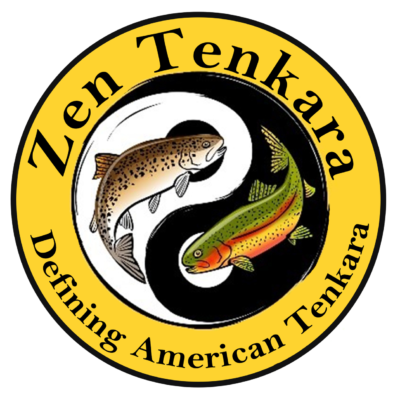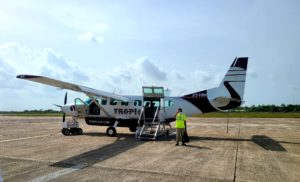 This summer I was lucky to be able to travel a few times to fish spectacular locations. One of my trips this past July was to Belize at Blue Horizon Lodge on Northeast Caye, due east of Placencia. It is a tiny island – if you can even call it an island. Really, it’s more like a small mangrove that has been turned into a caye by stacking rocks and conch shells around the parameter and bringing in fill sand on a barge. It’s small.
This summer I was lucky to be able to travel a few times to fish spectacular locations. One of my trips this past July was to Belize at Blue Horizon Lodge on Northeast Caye, due east of Placencia. It is a tiny island – if you can even call it an island. Really, it’s more like a small mangrove that has been turned into a caye by stacking rocks and conch shells around the parameter and bringing in fill sand on a barge. It’s small.
The lodge consists of several bungalows that are fresh and clean with full private baths, hot water and A/C. There is a staff building that consists of several rooms like a small 2 story apartment building, plus the main bar/dining room/gathering place. I believe they can host between 10 and 12 guests total. Besides a dock, a small area for playing corn hole and a place to rinse and store your gear, there isn’t much of anything else on the caye. It is a fishing lodge for those hardcore anglers not interested in snorkeling, eco-tours or lounging on the beach. You come here to fish.
To get here I flew from Denver to Belize City then took a smaller plane to Placencia about an hour and a half flight further south. The trip was easy. We did make one quick stop in Dangriga to pick up a single passenger which only took about 15 minutes total. The airport in Placencia is small and within a few minutes a van arrived to pick us up and drive us to the Placencia Hotel where a boat was waiting at their dock to take us out to the lodge. From the hotel to the lodge was a pleasant 45 minute ride in an open boat about 25ft in length, loaded with supplies for the week. The transfers were easy, everyone was helpful and very friendly. A notable plus: English is the official language of Belize which makes traveling there so wonderfully simple.
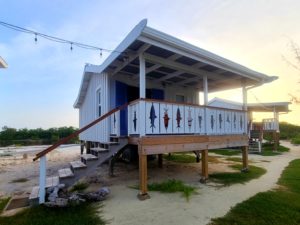
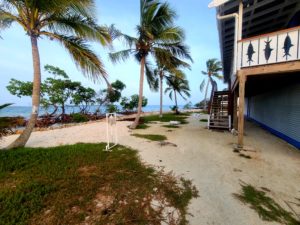
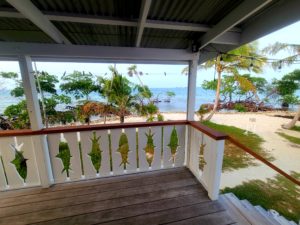
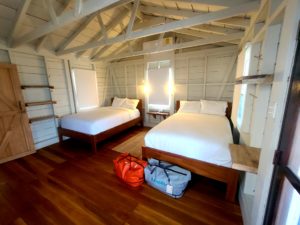
I was here to fish for permit. This is serious permit hunting territory with few “filler fish” to land. There are tarpon and the occasional opportunity for parrot or trigger fish, but Blue Horizon is where you go for permit. While there is a chance at a few bonefish, this area is almost null of them. Some time ago Northeast Caye and the surrounding flats were damaged by a hurricane. It destroyed much of the bonefish habitat. Additionally, up until barely a year ago, gillnets were still legal and widely used by the local fishermen. This practice had unfortunately wiped out much of the bonefish population. With new laws in effect and efforts to enforce and educate commercial fishermen underway, there is hope that bones will return and the area will see a substantial and steady growth in their numbers. Now, schools are few and far between. Places further to the north, like Turneffe Atoll or Ambergris Caye, are bonefish havens. Blue Horizon is for the serious permit hunter, period.
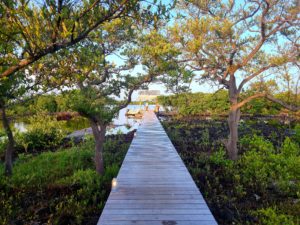
So, you may be wondering by now, when are the tips coming? I’m giving you a little back story so you can better appreciate them in a few minutes. See, I arrived very excited to fish and have an incredible week. That night I slept like a baby and had a first day of fishing that provided a few shots at tarpon and a couple of permit sightings. It was a good warm-up. At the end of the day, we arrived back at the dock and prepared to unload. The guide disembarked and tied the bow of the boat to the edge of the dock where there was a column that supported the roof. I picked up my gear bags and began to step off the boat with both hands full. As I stepped, the boat swung around, me in full motion, with one foot expecting to land on the wooden dock, but instead the boat moved.
With momentum behind me and gear bags weighing me down, BAM! Instead of my foot landing on the dock, my face hit, full force, straight down and frontal. I remember the sensation of smashing into something hard head-on. I remember my sunglasses being embedded into my face, and I remember my teeth feeling like they were slammed into a wall. Then, I remember people trying to pull me out of the water and everything hurting.
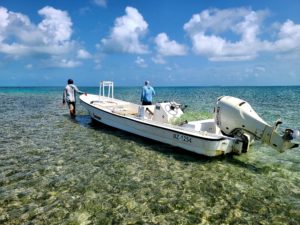
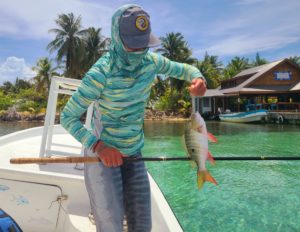
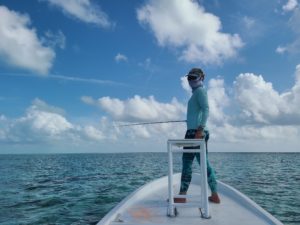
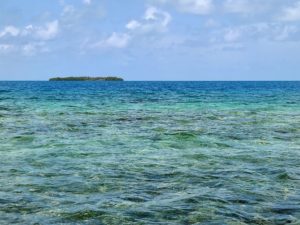
“Please stop! Just stop, please! I need to… just…please!” I was confused and trying to figure out what had happened. I was in the water. I could feel the bottom. My thigh was really hurting and my face and teeth had this throbbing pounding sensation. I tried to collect my wits and assess myself. “Do I have all my teeth?” I asked. Too scared to touch my mouth. “Yes.” was what I heard from a number of voices. I looked up at the guides and other anglers and their distraught faces terrified me. How bad was I injured? “Is my nose broken?” This time there was hesitation and not as many responded, “I don’t think so. It’s bleeding. So is your mouth and lips. Does anything feel broken?” I paused, and took in all the pain. “I don’t think so” I said. When they began to pull me out I noticed a broken piling under the water and suspected that I landed on it which was why my leg was hurting so much. Carefully and slowly I was raised back onto the dock.
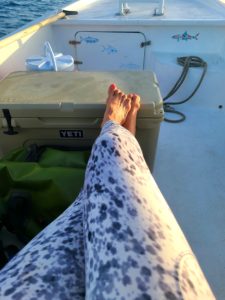
I was able to stand, and walk and I could feel that my face was swelling and tingling and that numbness was beginning to replace pain. I asked for ice to be brought to my bungalow and I slowly made my way there. I walked straight into the shower stall, slid down the side of it and sat under running water for what felt like about 20 minutes. When I got out and looked in the mirror, my nose was swollen and cut, but intact. My lips were bleeding and puffed like an over zealous Botox job, but didn’t appear to need stitches. My neck, arms, shoulders and left leg were all throbbing, but also seemed intact, although some serious bruising was already setting in.
I managed to swallow 600mg of ibuprofen and laid on the bed with a bag of ice on my face wanting to sleep, but knowing I shouldn’t. “Check my pupils and eyes periodically. I want to make sure I don’t have a concussion and please don’t let me fall asleep for several hours,” I begged my husband who was doting on me and seemed in shock from the whole thing. This in itself concerned me because he lives by the motto, “Suck it up buttercup.” The fact that he looked so distressed made me realize how serious of a fall I had had, and how unbelievably lucky I was to not need to be airlifted to Miami or Houston.
Bottom line, when traveling to remote locations…even non-remote locations, things can happen. Injuries can occur, illness can set in and medical attention is not always accessible. So here are a few things to consider for your next fly fishing trip whether it’s to a local stream or a remote lodge in another country:
- Pack a basic first aid kit including Band-Aids, gauze, and sterile waterproof tape. A sling, Ace bandage wrap, Benadryl, ibuprofen, anti-nausea medication, anti-diarrheic medication, topical hydrocortisone or a topical Benadryl, wound sealer, an eye patch and tweezers.
- Sunscreen and Bug Spray
- Medications or prescriptions
- Information on any allergies readily available
- A&D Ointment (great for scratches, sunburns, windburns and chaffing)
- Electrolyte supplements such as Nuun or Liquid IV (for those times when you just don’t drink enough water)
- Superglue (for fixing broken stuff including cuts, split lips and other injuries)
- A second set of sunglasses (just incase you lose or break your first pair)
- Cornstarch or Gold Bond Body Powder (great for chaffing and warm nights when it’s hot and humid)
- Insect Guard Clothing (this has become an indispensable part of my fishing gear for both travels to the tropics for saltwater fishing and also to Alaska- shirts, pants, hats, neck gaiters, sock, gloves…one or all. They make a HUGE difference)
- A head lamp (with extra batteries)
- A portion or small roll of duct tape (many random uses including taping cuts together, wrapping toes, covering sore heals or areas that are soon-to-be blisters)
- A few rubber bands (great for holding regular fly rods together when broken down in half or quarters and keeping them safe and secure without their case)
- Global Rescue Insurance (worth every penny when you need it)
The list above is certainly not all inclusive but are extra items that should be considered in addition to the necessary packing list specific to your fly fishing destination: Rods, reels, lines, flies, leaders, pliers, waders, boots, base layers, raincoats, warm layers, lightweight quick-dry pants, sun shirts, hats, lodge wear, scuffs, socks, collapsible/refillable water bottle, Lifestraw, SPF lip balm, gear bag and/or backpack, wading staff (if you need one)…covers most of your basics.
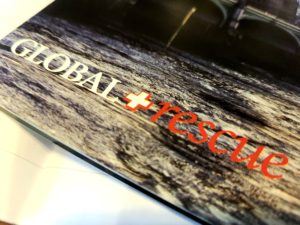
Global Rescue Insurance however, is something many look over but I urge you to really consider if you are traveling out of the country, especially to a remote destination. If I had been more seriously injured in my fall, I may have broken bones and teeth. I may have required stitches or incurred a serious head injury. Most small towns and many foreign countries simply do not have the medical care available that we have in the US. Even a very serious bout of food poisoning can become critical and care in the States is almost always preferred. I experienced this first hand when I became extremely ill for more than 3 days from food poisoning in Mexico. Dehydration can set in fast and I was unable to keep electrolyte fluid supplements downs. I was so thankful for have Zofran in my dopp/first aid kit that allowed me to get to an airport and be well enough to board a plane and return home. I was put on an antibiotic for 10 days as a result.
I was lucky. My recent trip to Belize could have been disastrous and left me critically injured or worse. Somehow I was spared broken bones, stitches, lost teeth, traumatic brain injury and concussions. But if things had turned out for the worse, at least I would have been prepared and I could have received the medical care I required. That alone is comforting. In the future, I will never step off a boat with both hands full. I’m not sure if I would have been able to grab hold of the column or do anything differently, but I’m certain, I could have at least broken my fall.
I woke early the following day after my accident and hesitated to get out of bed. I expected to be sore and I was. My neck and shoulder hurt and everything ached like I had been hit by a bus. I got dress, had coffee, ate breakfast and swallowed more ibuprofen. I was moving slow but was adamant I would fish that day. My casts were off all week. The boat rides made my shoulder, back and bruised thigh hurt with every bounce. I bit into nothing because my teeth felt loose and instead broke off tiny pieces of food and chewed them carefully – trying not to disturb my swollen and cut lip that bled off and on for the next several days. No one could believe I was moving and functioning, and wasn’t more seriously injured. “Damn girl, what are you made of, steel? You are tough, tough, tough,” said several of the guides. All I felt was sore, sore, sore but very grateful to have somehow avoided critical injury.
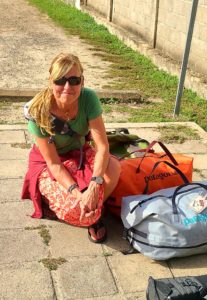
Fishing is fun. Be smart when you’re out there. Keep yourself safe and consider packing a few of the items above to make sure you are prepared should something go a little awry.
Tight Lines and happy fishing.
Karin


